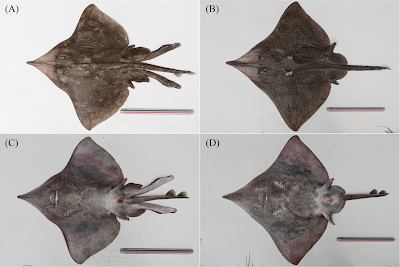Skate, Rajidae, are Batoids, Cartilaginous Fish related to Sharks, but with a flattened shape, that retain small dorsal fins, lack the tail spines of the related Stingrays, but have electric organs of uncertain purpose in their tails. Unlike Rays, Skate do not give birth to live young, but instead produce a distinctive egg known as a 'mermaid's purse'. Most Skate species favour deeper water, than Rays, with the group being most common on the outer continental shelves.
In a paper published in the journal Zootaxa on 1 May 2019, Francisco Concha of the Department of Ecology & Evolutionary Biology at the University of Connecticut, and the Facultad de Ciencias del Mar y de Recursos Naturales at the Universidad de Valparaíso, Janine Caira, also of the Department of Ecology & Evolutionary Biology at the University of Connecticut, David Ebert of Pacific Shark Research Center at Moss Landing Marine Laboratories, the Department of Ichthyology at the California Academy of Sciences, and the South African Institute for Aquatic Biodiversity, and Joost Pompert of Georgia Seafoods Ltd, describe a new species of Skate from the Falkland Islands.
The species is described from a population of Skate found around the Falkland Islands, that has previously been assigned to the Chilean Yellow-nose Skate, Zearaja chilensis, but suspected to be a separate, cryptic, species (i.e. a species which looks identical to another species, but which is genetically isolated from it) since 2012, when ichthyologists carrying out molecular studies noticed that population appeared to be distinct. A more detailed study carried out by Concha et al. now shows that (1) the Falklands Islands population does indeed represent a new species, and (2) the Chilean species, which is found along the southern coast of Chile and in the Straits of Magellan, does not appear to be sufficiently genetically distinct from the Long-snout Skate genus, Dipturus, to merit a genus of its own. The Chilean population is therefore renamed Dipturus chilensis, while the Falklands population is described as a new species.
Map showing geographic locations of specimens of Dipturus chilensis (diamonds) and Dipturus lamillai (triangles). Concha et al. (2019).
The new species is named Dipturus lamillai, in honour of Julio Lamilla, a Chilean biologist who devoted his life to teaching and research focused on the biology and conservation of Chondrichthyans, especially Batoids. The species is a large Skate, with adults typically over a metre in diameter, and the largest specimen 117 cm across, with a medium brown dorsal surface with lighter markings and a grey underside. The body is rhomboidal in shape with an elongate snout, with a scattering of thorns on the dorsal surface. The dorsal fin is deeply forked, and the tail quite short.
Adult specimens of Dipturus lamillai: (A), (C) Dorsal and ventral views of male, respectively. (B), (D) Dorsal and ventral views of female, respectively. Concha et al. (2019).
See also...
Follow Sciency Thoughts on Facebook.








